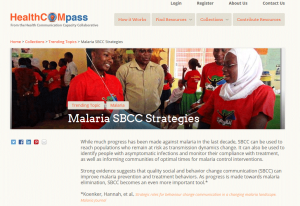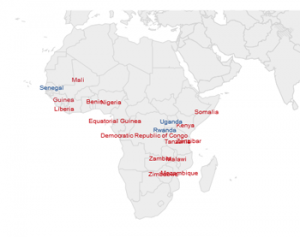Elements of an Effective Malaria Communication Strategy
 As a part of HC3’s mandate to build the capacity of national malaria control programs throughout sub-Saharan Africa, we have assisted a number of malaria programs with the development of their malaria communication strategies. These documents, usually timed to coincide with the production of a country’s malaria strategic plan, lay out a systematic way of addressing malaria with social and behavior change communication. Malaria and malaria communication strategies aren’t revised annually, they tend to cover a period of four to five years. A lot can happen in five years, so it’s important to focus not just on activities that have been proven to work in the past, but activities that address emerging issues like insecticide resistance, new guidelines for malaria prevention during pregnancy, and integrated community case management of malaria.
As a part of HC3’s mandate to build the capacity of national malaria control programs throughout sub-Saharan Africa, we have assisted a number of malaria programs with the development of their malaria communication strategies. These documents, usually timed to coincide with the production of a country’s malaria strategic plan, lay out a systematic way of addressing malaria with social and behavior change communication. Malaria and malaria communication strategies aren’t revised annually, they tend to cover a period of four to five years. A lot can happen in five years, so it’s important to focus not just on activities that have been proven to work in the past, but activities that address emerging issues like insecticide resistance, new guidelines for malaria prevention during pregnancy, and integrated community case management of malaria.
In the process of examining national malaria communication strategies we look for a number of critical elements:
- Does the document draw on formative research to ensure that priority behavior change activities are addressing country-specific issues?
- Are the malaria control and prevention behaviors promoted consistent with objectives laid out in the country’s malaria strategic plan?
- Are messages, materials, and activities described in terms of the program theory and intended audience?
- Do behavior change communication interventions address not only knowledge and awareness, but attitudinal factors like social norms, perceived risk, and self-efficacy as well?
- Is there guidance on how to design behavior change activities and programs in such a way that their impact can be measured?
- Are specific activities paired with target audiences (primary and secondary), and is the channel selected for each activity appropriate for that audience?
- Are there provisions for the local adaptation of messages, materials, and activities?
- Are SBCC objectives and related activities paired with health systems that are prepared to deliver the necessary commodities and services?
In the process of providing technical assistance to countries developing or updating their malaria communication strategies, HC3 has collected a number of the documents (18 in sub-Saharan Africa alone). We have briefly summarized each in a HealthCOMpass trending topic. Comparisons of policy documents is not recommended, as each country is dealing with malaria in their own unique context. These strategies provide snapshots of how far the design and evaluation of behavior change programs has come.

HC3 has analyzed and collected 18 national malaria communication strategies; click here to view the map and access each country’s strategy.








Leave a Reply
Want to join the discussion?Feel free to contribute!